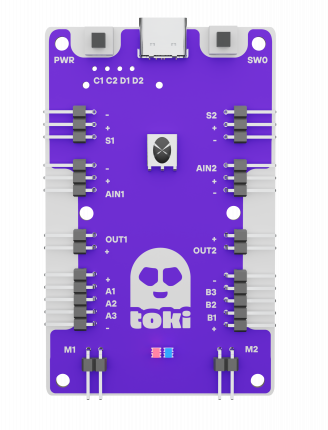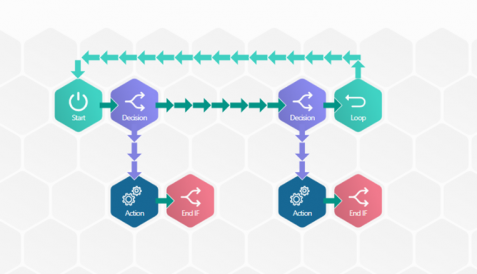Toki
Introduction
Toki is a development board developed by Yudu Robotics, based on a 32-bit RISC-V microcontroller operating at 64 MHz with Bluetooth Low Energy (BLE) for wireless programming. It provides 24 GPIO pins, a 12-bit ADC, 512 KB FlashROM, 26 KB SRAM, and an H-bridge motor driver, with programming supported via the PLODE environment. The board is intended for use in robotics, automation, and embedded systems, and is comparable to platforms such as Arduino and Micro:bit.
History
Toki was created by Yudu Robotics as an open-source RISC-V-based development board, intended as an alternative to AVR and ARM-based platforms. According to Yudu Robotics, it integrates wireless programming via BLE, motor control, and sensor interfacing in a compact form factor. The board includes built-in Bluetooth Low Energy (BLE), an onboard motor driver, servo connectors, and FET-driven outputs, enabling actuator control without additional hardware.
Hardware Overview
Processor - RISC-V Architecture
Toki uses a 32-bit RISC-V microcontroller running at 64 MHz. RISC-V is an open-source instruction set architecture (ISA) that differs from AVR and ARM Cortex-M architectures by providing an open and customizable instruction set. As a development board, Toki allows modifications for research and specialized applications.
Clock Speed Comparison
| Board | Clock Speed |
|---|---|
| Arduino Uno (AVR) | 16 MHz |
| Arduino Mega (AVR) | 16 MHz |
| Micro:bit V2 (ARM Cortex-M4) | 64 MHz |
| Toki (RISC-V) | 64 MHz |
Memory & Storage
- 512 KB Flash ROM – Stores program code.
- 26 KB SRAM – Handles runtime operations.
- Endurance – Flash memory rated for 1 million write/erase cycles.
Connectivity & Interfaces
Toki includes a range of I/O and communication options:
- Wireless Communication – Built-in Bluetooth Low Energy (BLE) for wireless programming and remote control.
- I/O Ports – 24 GPIO pins, of which 18 are available for general use, supporting analog, digital, and PWM signals.
- Analog Inputs – 12-bit ADC with 12 channels for precise sensor readings.
- NEC Communication Protocols – Supports SPI, I2C, and UART
Power System
- Power Inputs – USB-C (5V) or onboard AA battery holder (4.5V).
- H-Bridge Motor Driver – Drives two motors (M1, M2) with a maximum output of 2.1A per channel.
- FET Outputs – Two high-current outputs (2A max) for inductive loads.
Electrical Specifications
| Parameter | Description | Min | Max | Unit |
|---|---|---|---|---|
| Input Voltage | USB or battery power supply | 4V | 5.5V | V |
| GPIO Output Current | Max current per GPIO pin | – | 20mA | mA |
| H-Bridge Load Current | Max load per motor channel | – | 2.1A | A |
| FET Output Current | Max load for FET output | – | 2A | A |
Expansion & Control
Toki includes hardware expansion options for motion control, automation, and sensor interfacing:
- Servo Ports – Two dedicated ports for servo motor control.
- IR Receiver – Compatible with standard IR remote controllers.
- Analog Inputs – Two 3-wire input ports for sensors.
- GPIO Usage – 24 Total,18 general-purpose I/O pins available for interfacing.
Software & Programming
PLODE – Wireless Programming Environment
Toki can be programmed wirelessly via PLODE, a BLE-based environment for mobile, or via USB cable for web-based coding.
PLODE Features
- Cross-Platform Compatibility – Compatible with Android, iOS, and web platforms.
- Wireless Programming – Supports code uploads to Toki via BLE.
- Multi-Style Coding Options – PLODE provides block-based programming (comparable to Scratch) and text-based programming in Python or C++.
- Real-Time Debugging – Allows viewing sensor data and debugging during execution.
Example: PLODE Code:
Applications
Robotics
Mobile Robots – Equipped with an H-Bridge motor driver for controlling motors.
Robotic Arms & Motion Control – Features two servo motor ports.
Remote-Controlled Vehicles – Includes an IR receiver and BLE for potential wireless control.
Automation
Smart Home Control – Supports wireless relay activation, applicable to lighting or appliances.
Environmental Monitoring – Offers a 12-bit ADC for sensor integration in IoT projects.
Industrial Automation – Provides UART, I2C, and SPI interfaces for sensor connectivity.
STEM & Education
Block-Based Programming – Supports a Scratch-like coding interface.
Embedded Systems Training – Compatible with C++ and Python programming.
Physical Computing – Includes features for motor, sensor, and wireless projects
Market Adoption & Use Cases
Toki is designed for applications in education, prototyping, and small-scale automation projects. Its integration of Bluetooth Low Energy (BLE) and RISC-V architecture allows it to be used for microcontroller programming, wireless communication, and hardware development. The board has potential applications in STEM education programs and embedded systems training.
In addition to educational use, Toki can be utilized for prototyping IoT applications, motor control systems, and wireless sensor networks. Its compatibility with platforms such as Arduino and Micro:bit enables experimentation with embedded computing
Comparison with Other Development Boards
| Feature | Toki | Arduino Uno(ATmega328P) |
|---|---|---|
| Processor | 32-bit RISC-V, 64 MHz | 8-bit AVR, 16 MHz |
| Wireless Programming | Yes (BLE) | No (requires module) |
| Integrated Motor Driver | Yes | No (requires shield) |
| IR Receiver | Yes | No (requires module) |
| Servo Ports | Yes (2 dedicated) | No (uses PWM pins) |
| Analog Inputs | 12-bit ADC, 12 channels | 10-bit ADC, 6 channels |
| GPIO Pins | 24 total, 18 usable | 14 digital, 6 analog |
| Power Options | USB-C, AA Battery | USB-B, Barrel Jack |
| Price | $7.69 | $26.3 |
Limitations
While Toki offers several features, it also has certain limitations.
- Lower Community Support – Unlike the Arduino Uno, which benefits from a large, established community with extensive libraries and tutorials, Toki, as a newer platform, has a smaller support network.
- Different Programming Ecosystem – Toki uses the PLODE environment for programming via USB or BLE, rather than the Arduino IDE, requiring developers to adopt a different toolset.
- Limited Expansion Shields – Arduino Uno supports a wide range of shields for functionalities such as Wi-Fi, motor control, and sensors. Toki includes built-in motor control and wireless programming but has fewer third-party expansion options.
- Compatibility with Existing Arduino Code – Many existing Arduino projects use AVR-based libraries and low-level functions that may not work directly on Toki without modification, requiring additional effort to port code.
See Also
References
- Micro:bit Educational Foundation.(n.d.). Official Micro:bit Website. Retrieved from https://microbit.org/
- Höller, R., Haselberger, D., Ballek, D., Rössler, P., Krapfenbauer, M., & Linauer, M. (2019). Open-Source RISC-V Processor IP Cores for FPGAs — Overview and Evaluation. In 2019 8th Mediterranean Conference on Embedded Computing (MECO) (pp. 1-6). Budva, Montenegro. doi: 10.1109/MECO.2019.8760205.
- Yudu Robotics. (n.d.). Toki Development Board - Official Website. Retrieved from https://www.yudurobotics.com/home
- Yudu Robotics. (n.d.). PLODE - Toki's Wireless Programming Environment. Retrieved from https://edu.plode.org


